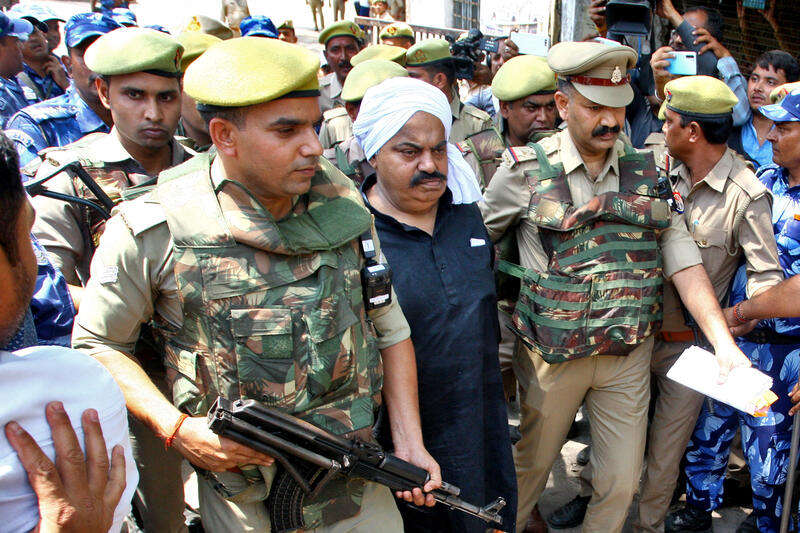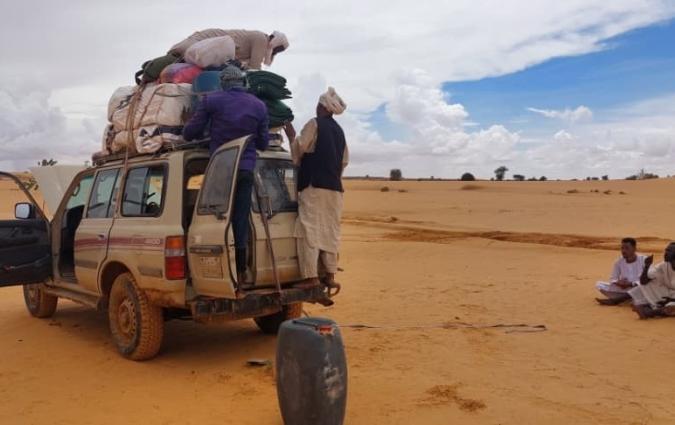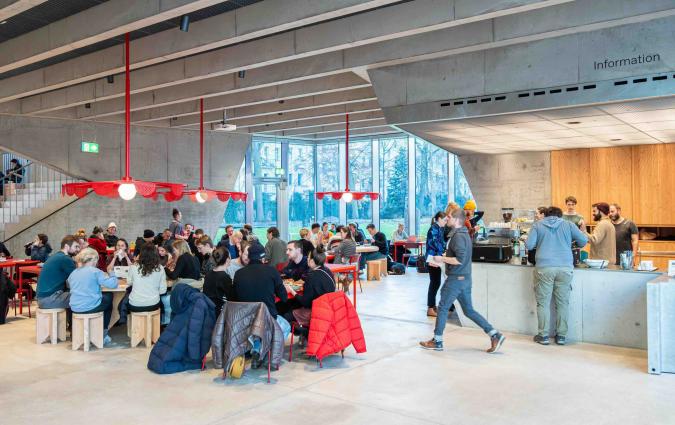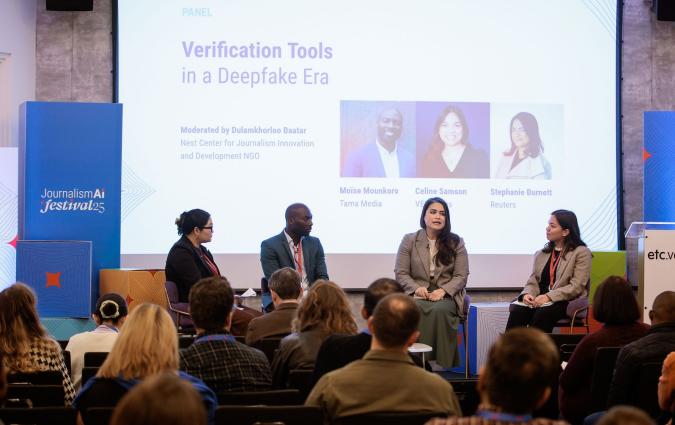Indian TV channels show the live shooting of convicted criminals. What does it say about the medium?

Police officers escort Atiq Ahmed, a former lawmaker in India's parliament, accused in several criminal cases, outside a court in Prayagraj, India, April 13, 2023. REUTERS/Ritesh Shukla
On the night of 15 April, two men in handcuffs were seen walking from a police jeep towards a hospital in the eastern Indian city of Prayagraj. Around a dozen policemen surrounded them. Journalists holding microphones and cameras swarmed them, shouting questions. At the time of the arrest, the men were being taken to the hospital for a routine medical check-up.
As the nation watched the scene live on TV, a man posing as a journalist pulled out a pistol and shot at the two captive men. Two more shooters emerged from the crowd and emptied out their barrels at the two men for about 40 seconds. The police did not do anything. The shooters then surrendered themselves. “We TV anchors live for such a story,” said a 37-year-old anchor at a leading Hindi news channel who was facing the camera as the live feed of the killings came in.
TV anchors, including the person quoted above, raised the pitch of their voices and declared that this was the first time India saw live murder on TV. The dead men were Atiq Ahmed and his brother Ashraf Ahmed, legislators and convicted criminals from Uttar Pradesh, a northern Indian state where the rule of law is often bent to suit the needs of the powerful.
For close to 48 hours after the shooting, TV channels breathlessly showed the murders time and again. Their correspondents enthusiastically rambled on about the details of the incident – where the shooters emerged from, the angle of the shot taken, how the police stood unaffected and how these kinds of gangsters saw a befitting end to their lives.
Senior journalist and author Kalpana Sharma calls this constant coverage a dangerous trend, as journalists did not bother to put the story in context. “They were so swept away by the dramatic visuals,” she says. “They even forgot that this was a blatant breakdown of law and order.”
Before the killing
TV channels in all regional languages as well as English began obsessing with the Ahmeds a few weeks before their murder. On 28 March Atiq Ahmed received a life sentence in a kidnapping case and was ordered to be moved from a high-security prison in the western Indian state of Gujarat to Uttar Pradesh, his home state.
The Ahmeds had approached the Supreme Court of India to stop the transfer as they feared they might be killed during the journey. “State machinery will take care of you,” the court said when refusing their request.
This was not the first time Atiq had approached the Supreme Court. In March, after the Chief Minister of Uttar Pradesh, Adityanath had declared in the state assembly that he would decimate the mafia through any means, Atiq had petitioned the Supreme Court to protect him, claiming a threat to his life.
On 11 April the Ahmeds and the police undertook an arduous 1,300-kilometre journey that lasted more than 24 hours. TV channels covered every inch of the trip, including a number of bathroom breaks. The anchor of TV 9 Bharatvarsh, a Hindi channel, asked the correspondent to zoom in while Atiq was urinating in public.
TV channels asked if the brothers would be killed in an extrajudicial manner, said Manisha Pande, Executive Editor of the media watch website Newslaundry. She added that the tickers and slugs on the screen used celebratory language.
A Hindi news anchor based in Noida said that TV news executives were getting information from Twitter and Facebook that their audiences wanted to see more of the Atiq story. She says they were advised to not cut away from the live feed tracking Atiq’s journey to Uttar Pradesh. The 32-year-old news anchor prefers to remain anonymous as she is not authorised by her channel to talk about these matters.
If the audience wants to see more of a story, TV news can cover it better by placing it in context, says Pande. “What happened to Atiq is not something anyone bothered to explain well,” she says.
The politics of Uttar Pradesh has always been defined by musclemen and criminals who then contest elections. According to senior journalist Sharma, the rival gangs that run Uttar Pradesh come from different parts of the state and have different illegal activities they are involved in. Sharma says they should have mentioned that Uttar Pradesh has gangs from different communities. Atiq’s gang was just one of those gangs. Many TV channels made it look like his gang was Muslim-majority and was one of the only gangs in the state. “There was no need to give it a religious colour,” she says.
TV news failed to explain Atiq’s rise and the reason he thrived in politics because they parachuted into the story, Pande says.
The shooters who killed the Ahmed brothers shouted 'Jai Shri Ram', the clarion call of the Hindu right wing before they surrendered. The TV channels caught this prominently but only a few raised questions about the links of the killers to right-wing groups.
The rise of authoritarianism
Atiq Ahmed’s killing needs to be seen in the larger context of the state’s Chief Minister Adityanath’s declaration that he would “clean out the state”, says senior journalist Pamela Philipose.
Ever since he was elected to power in 2018, the news media has glorified Adityanath, she explains, because the government is a major source of funding for the TV channels, which can’t survive without government advertising.
Moreover, the Rashtriya Swayamsevak Sangh (RSS), an umbrella Hindu nationalist organisation under which the ruling BJP falls, has a widespread presence in society. “They run the largest network of schools and hospitals other than the government. They also influence major civic institutions,” says Philipose. The media is no exception, she explains, as they exist within a democratic society as defined by the RSS.
Many journalists and editors at TV channels come from middle-class India, says Philipose. “Perhaps so do their audiences,” she says. The same Noida-based TV news anchor quoted earlier confirmed that the audiences are tired of long drawn-out justice delivery processes. “Our channel constantly gets messages from viewers on social media platforms saying they appreciate gangsters being eliminated,” she says.
It was on a TV interview that the Chief Minister of Uttar Pradesh had casually mentioned that “accidents might happen” to those the state brands as gangsters. Many news anchors used those words again and again to normalise extrajudicial action by the police. “No one asked follow-up questions to the Chief Minister,” says Sharma, who stresses that TV news channels created a strongman image for him.
Journalists should step in and reinforce the rule of law, explains Pande. “That is the job of a journalist,” she says.
Glorifying extrajudicial killings
India has a history of cheering for extrajudicial killings. This was clear in 2019, when policemen in the city of Hyderabad, Telangana shot dead four people accused of rape. Residents of the city walked along with the Telangana Chief Minister, lifted the policemen on their shoulders and showered rose petals on them.
This kind of praise for police forces was rampant in the 1990s when the Bombay police were killing mafia leaders on the streets of Mumbai, in a bid to eliminate gang violence from the city. “It was the civil society groups that managed to resist loudly back then,” says Sharma, who covered the period for daily newspapers.
Several media observers made the point that English-language newspapers asked the right questions about law and order, police incompetence and the blatant breach of the rule of law. That is how they differentiate themselves from the newspapers, says the TV anchor I spoke with. “We are a visual medium and our viewers are coming to us for a simple explanation of the news. And visuals! They want to feel like their questions are being asked,” she says.
The Supreme Court is now hearing petitions for an independent inquiry into the Ahmed brothers’ murders. The next hearing is on July 14.
Most TV news went on to ask if Atiq’s wife, Shaista Parveen, would be next.
She is now on the run.




